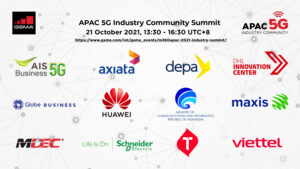
(Photo by Robyn Beck / AFP)
Can 5G be explained easier by GSMA’s newest association?
While the excitement for 5G grows, how many truly understand its full potential? But hark — businesses may soon find it easier to have the technology explained with the formation of a new industry community by GSMA.
The Asia Pacific is implementing 5G at great speeds, with Australia, greater Asia, and most of Southeast Asia already deploying the necessary infrastructure. However, one of the biggest concerns for operators was the lack of an ecosystem to better learn about the technology and the benefits that come with it.
There have been several 5G use cases being tested around the region, but many felt there wasn’t a platform to share their findings and engage in collaborative knowledge-sharing.
The GSMA predicts that 5G will contribute US$5 trillion to the global economy by 2025, as countries increasingly benefit from increased productivity brought about by the increased take-up of mobile services. 5G will benefit all economic sectors during this period, with services and manufacturing seeing the most impact.
Recently, the mobile industry association announced the formation of the Asia Pacific 5G Industry Community. It aims to become a new ecosystem for stakeholders and those intending on delivering Industry 4.0 and digital transformation from 5G networks, edge-cloud services, enterprise IoT and AI.
The 12 contributing members include AIS, Axiata, DEPA, DHL, Globe, Huawei, Kominfo, Maxis, MDEC, Schneider Electric, Telkomsel and, Viettel, who collectively have more than 500 members in over 30 countries.

According to GSMA’s Head of Asia Pacific, Julian Gorman, the main purpose of the industry community is to “unlock the power of 5G connectivity so that people, industries, and society thrive”. GSMA will play a leading role in supporting and amplifying the vital work the industry is doing at this time.
Huawei, which operates most 5G infrastructures in the region, has, in recent years, been working on supporting industries to identify viable pathways for 5G-connected services. Meanwhile, Malaysian telco provider Maxis will share their expertise and leverage GSMA’s best practices to showcase the possibilities 5G and other advanced technologies for the Malaysian marketplace.
Asian industries, infrastructure, and manufacturing are at an inflection point of implementing digital technologies and smart services, quips Dr. Gopi Kurup, Chief Executive Officer, Axiata Enterprise.
With pockets of the supply and value chains in more advanced states of adoption, the pandemic and economic situations have accelerated wider end-to-end implementation considerations. Industries dealing with food safety, assured healthcare, smart manufacturing, transportation, and logistics are at the forefront of the digital transformation and adoption curve in the region.
As part of the Industry Community, there are three Industry Interest groups: Manufacturing, Logistics, Port and Transportation, and Healthcare.
These groups will help members:
- Share 5G experiences to foster a learning culture that helps industry partners and innovators innovate
- Understand industry requirements, explore scenarios and applications of 5G
- Promote commercial use, reference, and best practices
- Network, build ecosystems and new partnerships
The community will also have several other benefits which include 5G industry reports and case studies as well as regular updates on the latest 5G industry developments and insights.
READ MORE
- Strategies for Democratizing GenAI
- The criticality of endpoint management in cybersecurity and operations
- Ethical AI: The renewed importance of safeguarding data and customer privacy in Generative AI applications
- How Japan balances AI-driven opportunities with cybersecurity needs
- Deploying SASE: Benchmarking your approach


